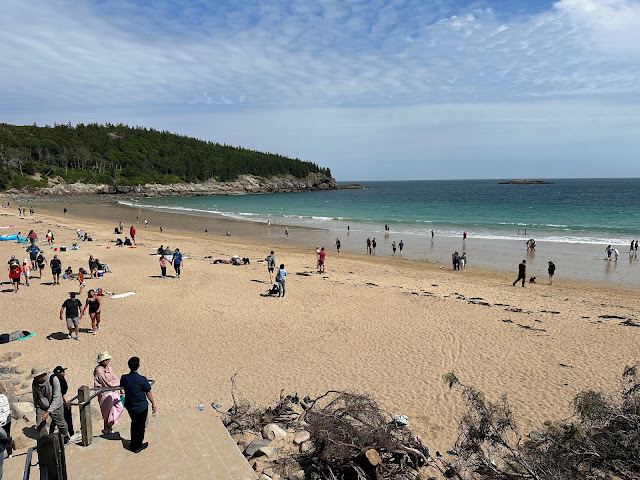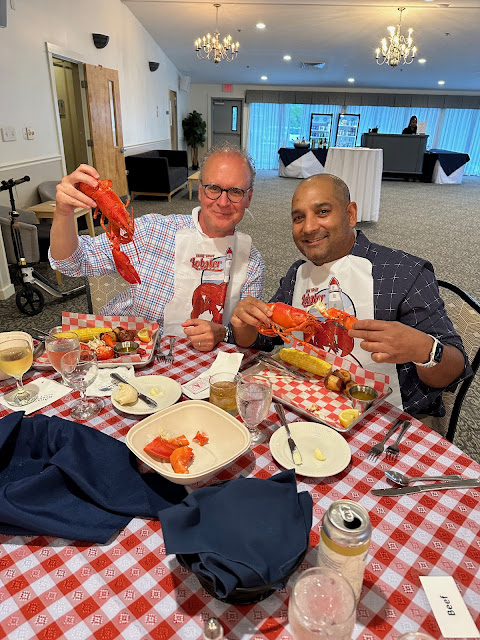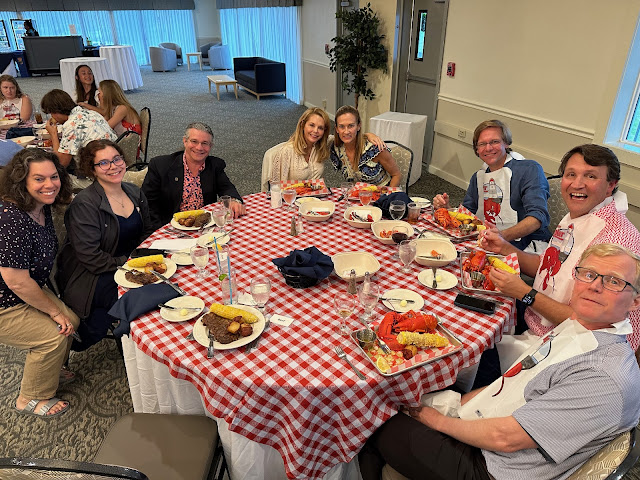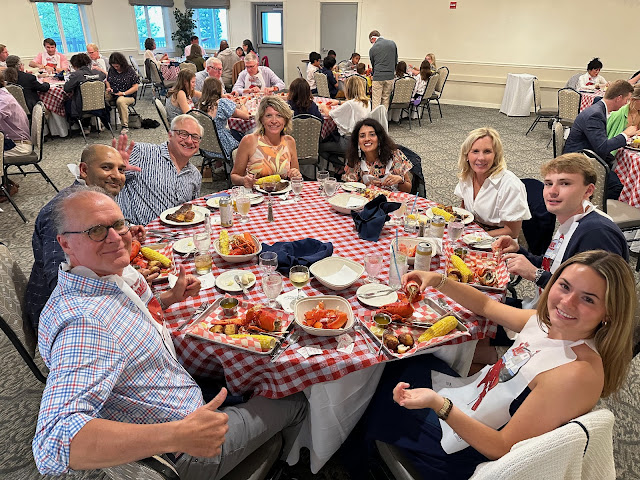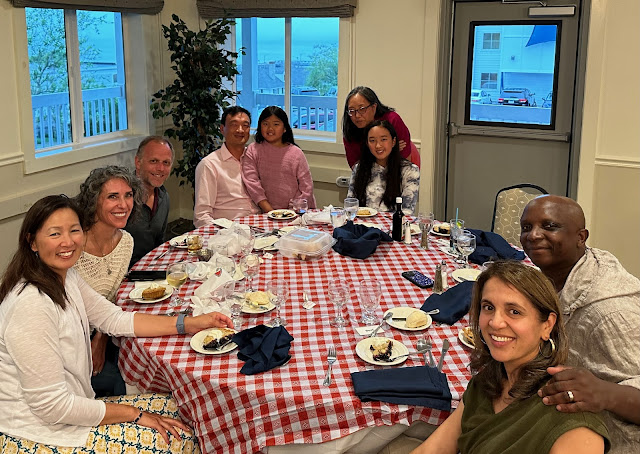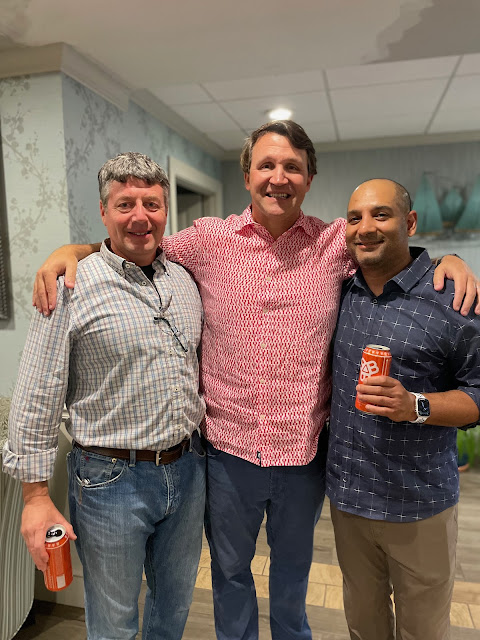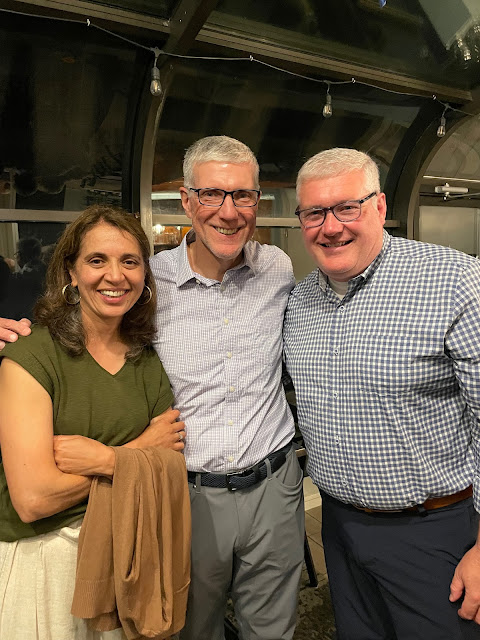It has been 18 years since the first Manus meeting. This was our 17th meeting since we missed 2020. That's pretty remarkable! This year’s meeting was sponsored by Endo and Enovis.
We gathered in beautiful Bar Harbor, ME next to the majestic Acadia National Park. Present this year were 15 members: President Adam, Steve, Rob, Becky, Glenn, Warren, Peter, Aimee, Marc, Milan, Tom, Kristin, Randy, Lana, and a warm welcome to Ruby Grewal and her family! The program was a well organized and planned combination of academic and non-academic topics, all of which sparked conversation and debate that even spilled over to our families. It was dynamic and exciting and one of the most enjoyable meetings for me.
Many people stopped in Portland on the way in, loading up on LL Bean goods and enjoying some delicious food and drink. Others spent time in the cute if touristy town of Bar Harbor. Blueberry ice cream, anyone?
On the eve of the meeting, we met at the gazebo behind the hotel to sample some bourbon and rye that Adam brought along. It certainly helped warm up the evening!
July 4, Day 1
Adam started us off with a presentation of a 50 yo man with a biceps rupture who underwent a single-incision biceps repair with a button. Surgery was done with a block, post-op the PIN was partially out. Randy led the votes to explore. Steve recommended high-res ultrasound. Glenn described the technique of putting a proximal tenodesis button through only one cortex, instead of the distal button through two cortices. Marc suggested using 2 intramedullary. If going bicortical, if the button is not flush on the bone intra-operatively, cut the suture and do it over. Interference screw not necessary. Steve described another technique - using Mitek G2 suture anchors. Use 2 - hold one, slide the other down and tie it. Put them in longitudinally so the sutures don’t fray when sliding. From med-legal perspective, does it look better to do something rather than wait? He explored 2 weeks later. Soft tissue had been pulled in and the nerve was tethered. No function returned. Tandon transfers performed after 6 months.
Adam:
Plug for volunteers for ABOS Part II exam
4 days long, 3rd week of July at the Palmer House in Chicago
A rewarding experience, giving back to the orthopaedic community
No commitment, won’t be called every year, can make it what you want
Peter:
Elbow arthritis - 2 cases
36yo collegiate javelin thrower. 25-110 ROM with a lot of DJD on xray. Advanced imaging? CT or MRI? CT for bony structures, MRI to evaluate for ligamentous injury. Patient underwent arthroscopic debridement. Had pain relief, 50% improvement in motion, and improved function. Question: do you get better, more complete bony debridement arthroscopically?
32yo male with a history of RA. 60-95 ROM, failed conservative management. He underwent arthroscopic-assisted interposition arthroplasty with Arthrex arthroflex acellular dermal allograft used to resurface the distal humerus preserving the MCL, using the hot dog bun method - sliding the graft across the joint securing medially first, and then laterally. No bridges burned for possible future procedures if necessary.
Rob:
Severe elbow arthritis in young patients
Review of biomechanics. Goal of treatment is stability.
Nothing new has been presented since 1976 - hemiarthroplasty, TEA, interposition arthroplasty (don’t distract!) - until Rob! Editorial: I have thoroughly enjoyed hearing about Rob’s journey toward elbow stability, his creativity and thinking outside the box, his trials and perseverance with the FDA, to possibly having his device for treatment of bidirectional ligament instability approved next month?? (Meaning August, 2024! Not sure when this post is actually getting to all of you!) Thank you, Rob, and congratulations!
Marc:
Forearm nailing
Review of biomechanics of a plate vs nail - long bones want to be nailed! “Long bone” includes phalanges and metacarpals, and recent evidence has shown good outcomes with nailing.
In the forearm, the ulna is a fixed “point” around which the radius rotates.
Some pearls: when doing ORIF, sometimes it is hard to hold provisional reduction for plate placement - try staple instead of a lag screw (Synthes was recommended) or a threaded k-wire (0.045) that is then cut flush with the bone (put something behind the bone because you may get no tactile feedback from the far cortex. Look carefully for non-displaced comminution or segmental fracture far from the main fracture - use a nail instead of a long plate requiring a lot of dissection.
Accumed 2nd gen vs 1st? The 2nd gen nail has a headless interlocking screw, and an option for a distal interlocking screw (but you pass the nail through the screw not the screw through the nail). You may need a mini-open incision to obtain reduction. BBFF? Plate the radius and nail the ulna? BMP, vivgen???
Glenn:
Virtual reality targeted brain rehab for phantom limb pain (PLP)
80% of amputees have PLP. This technique is an attempt at brain remapping. When the feedback loop is disrupted by the absence of a limb, the brain perceives pain. Things I learned: phantom limb pain can begin on Day 1. The lack of seeing a limb makes it hurt - put something under the blanket to resemble the missing limb, and pain is not as bad - what??! Patients lose their sense of laterality, and that is something that needs to be restored early to help with pain. The VR device can be used at the onset of pain and after a short time, the pain is relieved without the need for narcotics. Eventually, perhaps they can learn to use new prostheses with VR.
Editorial: Once again I am blown away by the capacity of Glenn’s brain. I tried to ask him how he has more hours in a day than I do, but he’s keeping that secret close to the vest. Congratulations, Glenn! So many patients are going to benefit from this. I have ideas, too, you know. I had an idea to paint flowers on the unpapered walls of my half-bath. But the only person benefitting from my idea is me. The world is a better place because of the ideas emanating from the brains of Manus members. I am continuously humbled by this group, and grateful for the chance to be a part of it.
Randy gave us an update on his private practice. In order to be able to maintain the independence of private practice, you have to be nimble because you are “under constant existential threat of a hostile takeover.” Invest in your younger partners - train them. Don’t hide anything from them because you need them for support. Partners need to cooperate, and time and money need to be put into marketing. Private practice is still worth the effort.
Milan gave us an update on his practice and working under private equity. They are 2.5 years into it, and so far so good. They are the main platform - the first practice, and then others are added on, so their experience may be different. But the PE has increased their marketing, access to expertise, and they have been able to grow because of economies of scale - EMR, HR, etc.
Hikes through gorgeous Acadia National Park filled in the afternoon. Some hiked all the way to the top of Cadillac Mountain, while others braved the Beehive trail. Some went into the town of Bar Harbor to sample the lobster rolls and clam chowder. The evening was topped off with a spectacular display of fireworks, some seen from boats, some from the park, and some from the hotel.
July 5, Day 2
Ruby:
Radial shortening vs PRC for Kienbock’s
The accepted teaching regarding treatment for Stage IIIa and IIIb is that it is better to salvage than save. But is it? Can you still do radial shortening for advanced stages of Kienbock’s? Ruby presented a multi-center study with 38 patients so far with 10 years mean follow-up. They are clinically better with RSO than with PRC - trending anyway. They have greater satisfaction, too. The PRC patients were surprisingly unhappy with their results. PE is no different between the two. RSO doesn’t burn any bridges and patients seem to like it better.
Kristin followed up with some Kienbock’s cases:
19yo Marine felt a pop after doing burpees (yet one more reason not to do burpees). He was diagnosed with Kienbock’s with fracture. Treated with RSO. Maybe scope the wrist to get info on the capitate and lunate cartilage for later SC or RLS fusion. If ulnar neutral and you can’t do a RSO, another option is core decompression with closing wedge osteotomy to reduce radial inclination.
57yo with Kienbock’s, ulnar neutral. Came for second opinion - had lunate revascularization with bridge plating and now worse than ever. Options?
First rule out infection. Cultures. Scope? PRC? RPNI for radial sensory neuroma?
68yo with Kienbock’s plus radiolunate DJD. Also had hip AVN prior to a THA.
Kienbock’s plus RL DJD. Underwent RSO with immediate pain relief. Corroboration for trying to save rather than immediately moving to salvage! In case you were wondering, these presentations will change my practice. Thank you, Manus! Again.
Steve:
Research data infrastructure - management and best practices
At HSS each surgeon seems to work in an isolated silo. There is a high drop off rate - it is challenging to get people to come back. How do you get the department working together toward common goals? That might solve some of the problems clinical researchers are facing: personnel, collecting and storing data, running and evaluating stats. How do you run your research efficiently when you feel like you’re on your own in a large group? How often do you meet? Who do you meet with? There are so many challenges, the biggest of which is funding. Work together, pool resources, etc but this would require cooperation!
Side discussion: cold therapy for pain management? It is used routinely by joint and sports surgeons. Sometimes no opioids needed. How about a nerve block with an indwelling catheter? 3-5 days, patients pulls the catheter on their own. Exparel? Don’t combine an indwelling catheter with cold therapy - risk for frostbite!
Tom:
Avoiding burnout
Read Compassionomics by Stephen Trzeciak
The answer to avoiding burnout - be compassionate. This is something that we need to try to teach medical students and residents. But sometimes the ability to show true compassion rather than trying to show compassion comes with age and experience. Showing compassion is also something that has to be taught to our administrators - they need to be compassionate toward us! We need to change the system from the top down in order to fight this disease that affects so many in medicine. The focus continues to be on what each of us as a physician can do to prevent it, but if those who need us - the universities, the foundations, the hospitals, and even our patients - can also show some compassion toward us as human beings, burn out amongst ourselves will decrease. Sorry - that was another editorial. I am on a roll…
Presentation by Endo Pharmaceuticals - Chris Randall, director of marketing
Takeaway - $5900/vial. When did that happen???? They say 88% of patients pay nothing for the treatment, 92% of commercially insured covered 100%, 100% of medicare B patients covered. There is a co-pay program that may cover up to $2500 of out of pocket costs to patients. They have a rebate program - buy and bill through a specialty distributor Best Medical. Direct consumer advertising - driving how patients want to be seen and treated, not specifically with Xiaflex. This strategy has been successful in making patients more aware of the condition.
APP are being trained to do these injections, but Endo is no longer promoting to rheumatologists. They are doing training by VR - can try it at ASSH booth in Minneapolis. There is a 0.1-0.3% rate of tendon rupture.
Multiple joints, multiple digits? 1/3 of a vial can rupture a spot in a cord. Spread a single vial out - you can dilute it more than they say you can. For interest: there are slightly more Dupuytren’s patients but twice as many vials are used by Urology. There are a wide variety of preferred Dupuytren's treatments among ourselves.
Aimee:
How Feminism failed me
It was the second wave of Feminism specifically, Liberal feminism, the one that said that women can do and have everything a man can and more. But they can’t. Aimee, who lived a life of choices which not all women have, found it hard to balance. She pursued her passion, and yet when she decided to go part-time it felt like a failure. While the feminist movement saw women sitting in higher positions, their overall presence in the workforce has not increased. Women did and still do prefer flexibility and stability over promotion and financial returns. In the same work, women still get paid less, but they’re ok with that?? Because they will take greater flexibility. There is more burnout in female physicians, and overall female happiness has declined since the mid-’70’s across all disciplines. What did she wish had been different? That she could have made all her decisions with a better and earlier understanding of what the ramifications of those decisions would have been. Another editorial: I love the conversation that this talk sparked among our members, among our members with their partners, among everyone together. What can Manusians do? Be supportive, don’t patronize, listen. It is difficult for a man to advise a female resident or fellow on these things. The last thing you want to do is tell a woman not to pursue her passions. Once again, we are asking each individual woman to try to navigate this on her own. If the administrators, the universities, the foundations, the hospitals would value their female providers, then there would be better infrastructure to support women to be able to pursue their careers and still have a family if that is what they want.
It was a bit overcast and foggy but that didn’t stop us from more exploring of Acadia. We then met back at the hotel for the family dinner. As usual the kids bonded and ran off, playing games and roasting s’mores.
July 6, Day 3
Presentation by Enovis - Perry Lynch
Silicone MCP and PIP joint replacements - square stems, no grommets. Sorry - that’s all I got out of that presentation! It looked good, really!
Warren:
The Grass is Always Greener - making a mid-career change
4 years in Cleveland then 16 years in Rochester. The last 2 years were challenging, and COVID didn’t help. He felt he had built something solid, recruited others there, but he was not loving the daily work anymore. Had to have support of family before making a big change, had to have appropriate expectations, and had specific relocation criteria. He called Marc at Duke to inquire about possible available positions. It was only after several minutes that Marc realized Warren was not asking for a fellow, but for himself! Lou, Dan, and Jon all made similar mid-career changes. The move to Duke turned out to be a great fit and he is very happy (sigh of relief from Marc!). He has no regrets.
Business meeting - presented by Becky
But before getting down to business, Becky went off-script to make a plea for everyone who hasn’t done it already, to make a will! You can start with something simple, get a form online like here, tighten it up later. But do it now! A couple a points to consider: if you have a 529 account for your kids, be sure to assign a successor owner, not just a beneficiary and not just an administrator. If you don’t, and something happens to you, the account could get folded into your estate and lose its 529 designation and its tax advantage. Also, if you have ever dissolved any legal entity, a business, a marriage, anything, go check the paperwork to make sure everything has been signed and dated appropriately. Sorry for the downer memo, but it’s that time, we are at that age, and you don’t want to leave anything to chance. Also, I learned that there are members here who don’t have a will! Go do it now! OK - off my high horse…
Numbers as compiled by Ray for 2023 and 2024, to date, were presented in a less than knowledgeable fashion. Sorry, Ray! But my lack of understanding sparked some discussion about how we as a group should know a little more about the financials of the club. Perhaps a couple of people should review the books with the Treasurer periodically so more people are familiar with the numbers. Also, given the amount of work involved in being Treasurer there was a motion to rotate the position along with creating a small committee to help review the books as needed. Kristin volunteered to take the reins, followed by Tom. Thank you, Kristin and Tom! The term will be 5 years, with overlap in the first and fifth years. In 2024-2025, Kristin will work with Ray to make the transition. In 2028-2029 Tom will work with Kristin to make the next transition. Each year the Treasurer will review the books with a committee of 2-3? other members. So far Randy has stepped up to help with this. I think the treasurer-elect should be another member (OK Tom?) If anyone else would like to be a part of the committee please let us know! At the 2029 meeting we will ask for a volunteer to take over from Tom. Something to think about…
Questions came up during review of the accounts about what happens if the expenses of a meeting go over what is collected from sponsors. After some discussion, we decided that Manus would cover the first $5k in overages, the rest being covered by the members in attendance. How that would be divided among attendees was not discussed in detail. I suggest we put that on the agenda for discussion at the next meeting.
The list of shame was posted - members who still have outstanding dues. The subject of annual dues was brought up again. We raised the amount to $1000 last year because of the anticipated increased cost of Greece. At that meeting we voted to keep the amount at $1000. After another short discussion, we confirmed that dues will remain at $1000/year moving forward. Glenn has volunteered to contact those on the list of shame, and he started by calling some members sitting right here in our meeting room.
The difficulty in obtaining sponsorship early enough was also brought up. Adam was waiting on final numbers up until quite late, causing understandable stress and anxiety. Given the way that industry plans their budget, we decided we should make our annual meeting plans 2 years in advance, allowing us more time to lock in sponsorships, and maybe even in greater amounts. In order to do this we need to choose our location and president, dates, and have a rough idea of who will be there, along with an agenda, 2 years ahead of time. Every member should propose a topic to present, even if there is a possibility that he/she might not make the meeting. Topics can change, of course, as we get closer to the meeting. So…everyone start thinking about a talk! It can be related to hand surgery, practice management, life changes, hobbies, anything you want.
On that note, let’s see where we will be going next year! Nominations for Manus 2025 included:
Hawaii
Carmel/Pebble Beach
Broadmoor, Colorado Springs
Alaska
San Diego
Salt Lake City
Big Sky Montana
Ojai Valley Inn
After the vote, the group decided on Ojai Valley Inn with Broadmoor as a back up plan. And congratulations to our new president - Peter!
There were also nominations for an international trip in 2026. However, after further discussion, many felt it was too soon after our big expensive trip to Greece to consider another blow-out bash. Instead, we decided 2028 would be the next year to consider destinations like Spain, Patagonia, Portugal, Switzerland, or Japan. But perhaps, in 2026, we might consider something like Cabo San Lucas (right, Aimee??) Once President Peter confirms our 2025 location, we will solicit nominations for 2026 - anywhere within North America or Central America. Like Cabo. And take a vote over email. Next year we will nominate locations for 2027, and an international site for 2028. This way we will stay at least 2 years ahead to ease planning and secure sponsors. We also voted to lift the strict East/West alternating years. We will try to keep it as easy as possible for as many members as possible to attend every meeting, while still going to fun and interesting places. (I do want to point out that I was the only West coast member to make the meeting this year!) This means that even though next year will be in the west, we can still go somewhere, say Cabo, the following year!
Tsunami presentations
Tom:
70yo with bilateral shoulder pain. On the right, started with rotator cuff repair, which failed. Followed with a total shoulder, which became infected. Hardware removed and replaced with antibiotic beads. Reinfected. Left with a spacer in place. Then on the left, started with hemi-arthroplasty. Stable but still had complaints of pain. An injection into the CMC joint (?) has solved the problem for now.
Peter:
90yo with distal humerus fracture. Speedboat racer! 2 months out from injury the medial column is shortened, but without any ulnar nerve symptoms. There is swelling, minimal motion, paper thin skin, and some pain. Consensus was to leave it alone and let it settle down, and it will probably be fine. In other words, do nothing! And avoid being the next tsunami winner!
Steve:
Infection following a trigger release. Now with contracture and pain, mainly of the long finger but affecting all the other fingers in a reverse quadriga effect. Minimal passive motion of the long finger. Advice from others: do nothing! It was explored, digital neurolysis, and the tendons excised. Now has a more functional hand with improved pain, though the long finger doesn’t move.
Peter (#2!):
6yo with bbff treated at an outside institution using poor technique (inadequate plates). No rotation. Patient developed ulnar nerve dysfunction that was chalked up to “post-op hematoma”. 1.5 years later, no sensory function, flexible clawing of the ring and small fingers, no pain, negative Tinel’s. Glenn: nerve transfer for sensation, and tendon transfers for motor. Steve: explore to see if nerve is just tethered. Use kerrasin rongeur for neurolysis from bone. Marc: should have nailed them both!
And the plaque goes to…. Tom!
(Who has the plaque?)
Moving forward we are reinstating the requirement for every attendee to present a tsunami. We might not get to every case, but everyone should have one prepared. There is always something to learn from each other, so bring something to present even if you don’t think it’s going to be a “winner”. It would be great for those of you who did present cases to share some follow-up when appropriate. We’d all love to see what decisions you made, and what the outcomes are.
A few members had to leave immediately after the meeting. Many of the rest of us gathered for a group hike with our families around Jordan Pond. The misty, foggy weather made for interesting scenery, although we were denied a view of the Bubbles. But we could see how Steven King might have gotten some of his inspiration!
Beavers at work!
We gathered for a final dinner followed by drinks and more conversation. I got to know some of you better, learning some things that I am sad to say took me this long to find out. Like the fact that Marc played water polo for Stanford (or just that Marc and I share an alma mater - I won’t tell you how many years apart we graduated). Or that Glenn played on a championship Little League team, and also got to meet the longtime trainer for my favorite baseball team (Gene Monahan - I remembered his name!). Or that Adam’s son and Rob’s daughter are fanatics of F1 racing?! I pledge to learn more about each of you because your stories are so inspiring. I know I express my love for all of you very often, but I want you to know it is genuine. I have always known that being a part of this group has contributed immeasurably to my professional life, and I am finding more and more that my personal life, too, is fuller because of Manus.
I hope you enjoyed this edition of the Manuscript. I have written my will. None of you are getting anything. But I do still love you.
Madam Secretary






